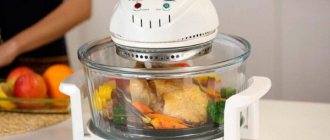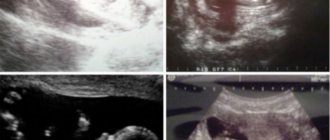Measuring body temperature is necessary to assess the state of human health, because many physiological and pathological processes in the body are accompanied by an increase or decrease in the temperature of the entire body or its individual parts.
You can measure body temperature using a medical thermometer (thermometer) - mercury, electronic, infrared. As you know, a person is a warm-blooded creature, that is, his body temperature is maintained within fairly narrow limits (36-37°C) thanks to a complex thermoregulation system. However, in some painful conditions, this seemingly perfect system of protecting a person from overheating or hypothermia can fail. And at this moment, measuring body temperature allows you to timely assess the condition of the body and take measures to identify the cause of the disease and treat the disease.
Measuring body temperature: terms
The internal environment of the human body maintains a constant normal body temperature - 36-37°C.
Let's look at the necessary terms, definitions and processes. Thermoregulation is a set of processes regulating heat generation and heat transfer. Maintaining a certain balance between these processes ensures a relatively constant body temperature in a healthy person.
Heat generation is carried out due to oxidative processes in muscles and internal organs: the higher the metabolic rate, the greater it is.
Heat transfer occurs through heat conduction, heat radiation and evaporation (sweating).
As the ambient temperature rises, the blood vessels of the skin expand, its thermal conductivity and heat radiation increase, and sweating increases, which leads to increased heat transfer and prevents overheating.
When the ambient temperature decreases, heat transfer decreases due to a decrease in thermal conductivity of the skin and narrowing of its blood vessels, heat production increases due to increased contractile activity of skeletal muscles (muscle tremors), which prevents a decrease in body temperature and hypothermia.
Body temperature is an indicator of the thermal state of the body, regulated by a thermoregulation system consisting of the following elements:
- thermoregulation centers (brain)
- peripheral thermoreceptors (skin, blood vessels)
- central thermoreceptors (hypothalamus)
- efferent pathways
The thermoregulation system ensures the functioning of the processes of heat production and heat transfer, due to which a healthy person maintains a relatively constant body temperature.
As mentioned above, normal body temperature is 36-37°C; daily fluctuations are usually recorded in the range of 0.1-0.6 °C and should not exceed 1 °C. The maximum body temperature is noted in the evening (at 17-21 o'clock), the minimum - in the morning (at 3-6 o'clock). In some cases, a healthy person experiences a slight increase in temperature:
- during intense physical activity
- after eating
- with strong emotional stress
- in women during ovulation (increase by 0.6-0.8°C)
- in hot weather (0.1-0.5°C higher than in winter)
The following degrees of temperature increase are distinguished:
- low-grade fever - between 37 and 38°C
- febrile - between 38 and 39°C
- high, pyretic - between 39 and 41 °C
- excessively high, hyperpyretic - over 41°C - life-threatening, especially in children!
Read also: Intravenous injection: execution algorithm, rules, possible complications
!!! The lethal maximum body temperature is 43 °C, the lethal minimum temperature is 15-23 °C.
Thermometry is the measurement of human body temperature. The measurement is carried out using devices and instruments.
Fever is an increase in body temperature above normal levels due to impaired thermoregulation and an imbalance between heat production and heat transfer.
Crisis - a sharp drop in temperature within an hour.
Lysis is a decrease in body temperature over several days.
Demercurization is the removal of mercury and its compounds by physical, chemical or mechanical methods in order to prevent poisoning of people and animals.
A temperature sheet is an independent medical document, which, in addition to indicating the morning and evening temperatures, notes the pulse rate, blood pressure level, respiratory rate, body weight and, in the presence of edema, its dynamics, the volume of fluid taken per day and daily diuresis, the presence of stool during the day, the time of taking a hygienic bath or shower.
Temperature is marked in green, pulse in blue, blood pressure in red (in the form of bars). When filled out carefully, the temperature sheet helps the doctor well in his practice.
Temperature measurement through the ear
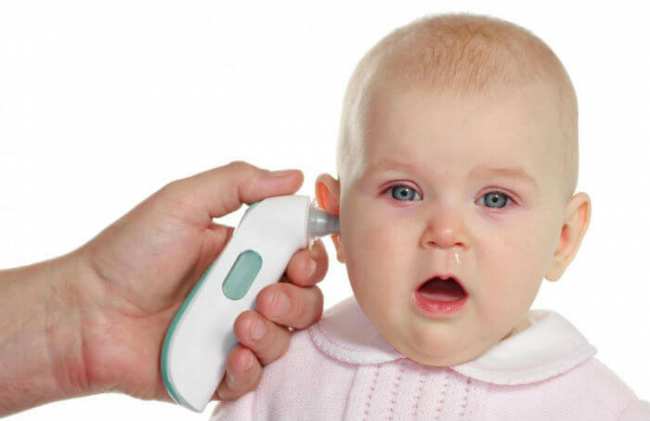
Data can be obtained with this method of measuring body temperature only using a special infrared thermometer with a soft sensor tip. The error in this case will be minimal.
To take a measurement, you need to insert the sensor into your ear and hold it in that position for a few seconds. This method of measuring human body temperature is considered one of the fastest. The limitation for its implementation is the age of up to 6 months, since in this case the data obtained will not correspond to reality.
Types of medical thermometers
Body temperature is measured using thermometers, which can be divided into two main types:
- contact
- contactless
Contact thermometers include devices that determine body temperature readings only through direct contact with the surface of the body for a certain time:
- The mercury maximum medical thermometer is the most common in use. It is a glass vessel with a reservoir filled with mercury, which rises through the capillary as the temperature rises. The most accurate, but there is a danger of evaporation of toxic mercury vapor if its integrity is damaged. In this case, immediate demercurization is required.
- Galinstan medical thermometer - looks like a mercury thermometer, but a mixture of gallium, indium and tin is used as a filler. Safe, but not very convenient to use: measuring temperature requires more time and a very tight fit of the thermometer surface to the skin. “Shaking off” to the minimum level requires effort.
- Digital (electronic) thermometer - measures body temperature using a special built-in sensitive sensor, and displays the measurement result digitally on the display. Electronic thermometers have a number of additional functions in the form of a memory of the latest measurements, sound signals for the time of measurement and measurement results, replaceable tips for hygienic use, and waterproof housing. Children's electronic thermometers are produced in the form of pacifiers.
- Thermometric strips are indicator strips with a scale coated with a liquid crystal emulsion. The strips are applied to the forehead and after 20 seconds the temperature is judged by the color change. With this method, the temperature is measured without tenths. The method is considered preliminary: it requires further definition. The accuracy of the readings is affected by drops of sweat on the forehead, lighting, the tightness of the strip to the body, and the storage conditions of these temperature indicators.
Read also: Intravenous infusion: execution algorithm, indications, complications

Non-contact thermometers include those that measure temperature without direct contact with the surface of the body:
- Infrared tympanic thermometer - allows you to instantly measure body temperature in the ear canal. Determines the temperature of the eardrum without contacting its surface. It is highly accurate. Convenient in pediatric practice.
- Infrared Forehead Thermometer - Instantly measures temperature without skin contact. The thermometer is placed 3-4 cm from the surface of the forehead, then the start button is pressed. A high-quality calibrated device gives fairly accurate results.
Non-contact measurement methods
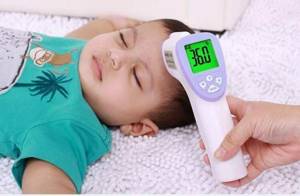
You can obtain the necessary data without direct contact with the patient. This became possible with the help of infrared thermometers, which appeared not so long ago. Their principle is based on determining the amount of heat from the person being diagnosed with further conversion of the information into an electrical signal. Infrared thermometers give an error level of 0.1–0.2 degrees.
Non-contact methods of temperature measurement allow you to obtain the necessary data in 1–3 seconds. To do this, it is enough to bring the device to the forehead of even a sleeping person. This procedure reduces the likelihood of transmission of infection through the device, since there is no direct physical contact. Therefore, this method is ideal for public institutions: hospitals, medical facilities. offices, schools, kindergartens.
Measuring body temperature with a mercury thermometer: algorithm
Thermometry in medical institutions is still carried out mainly with maximum mercury thermometers. In a hospital setting, body temperature is measured twice a day - in the morning before breakfast and in the evening after dinner. As prescribed by the doctor, for some patients - every 2-3 hours.
Locations for measuring body temperature:
- armpit (most common)
- oral cavity (thermometer placed under the tongue)
- inguinal folds (in children)
- rectum (in seriously ill patients and according to indications)
Oral temperature is usually 0.5 degrees lower than rectal temperature (measured in the rectum) and 0.5 degrees higher than body temperature measured under the armpit. Body temperature measured in the inguinal fold is close to the temperature in the oral cavity.
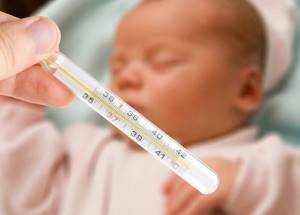
Preparation for the procedure
- Prepare: a clean dry thermometer (check integrity, shake off mercury to 35 ºC), watch, pen, temperature sheet, clean gloves, container with disinfectant solution, individual napkin for the patient, for measuring in the rectum - Vaseline
- Introduce yourself to the patient and identify him. Create an environment of trust
- Explain to the patient the purpose and course of the procedure, obtain his verbal consent to perform
- Wash your hands hygienically, dry them, put on gloves
Execution and completion of the procedure
Measuring body temperature in the armpit
- Examine the patient's armpit. If there are inflammatory phenomena in both armpits, do not carry out thermometry, because the result will be unreliable, inform your doctor
- Wipe the wet armpit with an individual napkin.
- Place the thermometer in the patient's armpit so that it is in full contact with the surface of the patient's skin - the patient must press his shoulder to the chest. Make sure that there is no underwear or clothing between the thermometer and the patient’s skin.
- Body temperature measurement time: 10 minutes
- Remove the thermometer, read its readings, and inform the patient of the result.
- Place the thermometer in the container with the disinfectant solution
- Remove gloves, wash and dry hands
- Register the result of thermometry in the medical documentation (temperature sheet, nursing history)
- If a patient has a fever, notify the attending physician or the doctor on duty.
Read also: Vacuum blood sampling: system components, procedure algorithm
Measuring body temperature in the inguinal fold is carried out using the same algorithm
Measuring body temperature in the oral cavity

- Examine the patient's oral cavity. If there are inflammatory phenomena in the oral cavity, do not perform thermometry, because the result will be unreliable, inform your doctor
- Place the thermometer reservoir in the posterior sublingual pocket on the right or left. Ask the patient to gently close their mouth and hold the thermometer, being careful not to damage the thermometer with their teeth.
- The minimum time for measuring temperature in the oral cavity is 2 minutes
- Ask the patient to open his mouth. Carefully, without touching the patient’s teeth with the thermometer, remove the thermometer
- Take readings and inform the patient of the result
- Place the thermometer in the container with the disinfectant solution
- Remove gloves, wash and dry hands
- Register the result of thermometry in the medical documentation (temperature sheet, nursing history)
- If a patient has a fever, notify the attending physician or the doctor on duty.
Measuring body temperature in the rectum
- Ask the patient to lie on his side, bend his legs at the hip and knee joints
- With the first and second fingers of the left hand, spread the patient’s buttocks and examine the anal area. In the presence of inflammatory phenomena, do not measure temperature, because the result will be unreliable. Tell your doctor
- If there are no contraindications, lubricate the thermometer reservoir with Vaseline.
- Insert a thermometer into the patient’s anus to a depth of 3-4 cm. If resistance is detected in the rectum, immediately stop manipulation and inform the doctor
- The minimum time for measuring temperature in the rectum is 2 minutes
- Remove the thermometer, read its readings, and inform the patient of the result.
- Wipe the patient's anal area with a tissue
- Place the thermometer in the container with the disinfectant solution
- Remove gloves, wash and dry hands
- Register the result of thermometry in the medical documentation (temperature sheet, nursing history)
- If a patient has a fever, notify the attending physician or the doctor on duty.
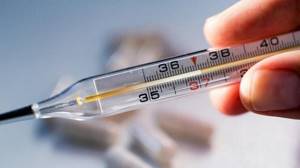
In the oral cavity and rectum, the temperature is normally 1°C higher than in the armpit.
In elderly people, a body temperature of 35.0°-36.0°C, in newborns – 37.0°-37.2°C is considered normal.
Thermometers for measuring rectal temperature are labeled and stored separately from the rest!
Oral measurement
The oral method of measuring temperature is often used in Western countries. According to experts, it allows you to obtain readings with minimal error. The main contraindication for the procedure is age under 4–5 years, since it is believed that the child is unable to properly fix the device in the mouth.

However, an innovative pacifier thermometer solves this problem. In this case, you can measure the temperature even of a sleeping baby.
When using a regular thermometer, the temperature should be measured under the tongue or behind the cheek. During the procedure, you must close your mouth and breathe through your nose until it is completed. During this time, the tip of the device should be pressed against the bottom of the tongue.
The duration of the measurement procedure is from 10 seconds. up to 3 minutes depending on the type of thermometer. With the oral method of measuring body temperature, the norm is 36.3–36.9 degrees.
conclusions
The main indicator of human health is temperature. Temperature measurement methods help identify the inflammatory process at the initial stage of development. This allows timely treatment to be applied and stop the further spread of the infection.
Therefore, every person should know how to properly use thermometers to determine temperature. After all, with the help of this data, you can track many health problems and prevent further deterioration of the situation.




